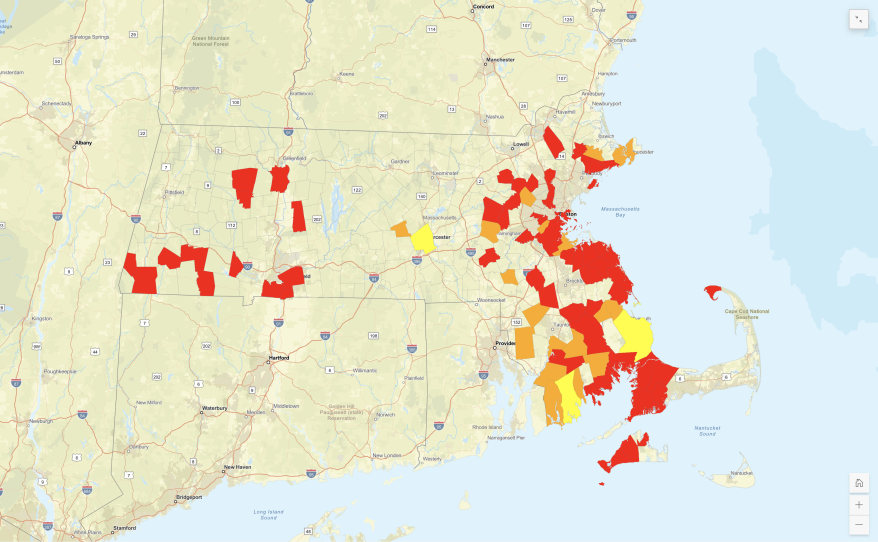A tiny worm is attacking beech trees across Massachusetts, and arborists say they're worried the long-term impact could devastate a species that's critical to the state's forests.
The worm causes beech leaf disease, which was first identified in Ohio in 2012 and appeared in Plymouth, Massachusetts, two years ago.
"It has quickly spread throughout the state," said Nicole Keleher, director of the state's forest health program. "I believe we've detected it in over 80 communities at this point, and it's been found in every county. So it's well established throughout the state and is causing significant impact to our beech resources."
Keleher said her team is conducting surveys around the state to identify the disease, but they're finding it even when they're not looking for it.
"I was out hiking with my daughter and just looked down on the ground and saw an infected leaf, and was able to find the tree it came from," she said. "And a lot of homeowners are beginning to see it in their trees."
Certified arborist Joshua Fritz of the tree care company Hartney Greymont said he's seen four cases of the disease in the past month.
"Last winter, [the sick trees] weren't there," he said. "Now I'm seeing pockets in Concord and Lincoln pretty regularly."
The disease causes distinct markings on leaves that make it relatively easy to identify in affected trees.
"At early stage, you can look basically are under the canopy and let the sun penetrate through the leaves and you'll actually see black bands within the margins of the veins in the leaf," Fritz said.
Over the winter, Keleher said, the microscopic worms that cause the disease — called foliar nematodes — can get into the buds and do more severe damage.
"In the spring, you actually won't have any leaves that come out at all," she said. "And that's when we start to see dieback and declines."

It's such a new disease, Keleher said, that there's still much that isn't known about it.
"We really don't know how this disease will function long term or what conditions will allow us to be more successful in surviving," she said.
And that's made it hard for arborists to know what to do about infected trees.
Nicholas Brazee, a plant pathologist at UMass Amherst, said they've never seen a situation where a foliar nemotode like this has killed trees.
"So that's made management extremely difficult," he said. "In the past when there's a new insect or disease that emerges, there's a lot of parallels from previous diseases or insects, so we have some understanding of how to manage them. But this is such a new situation that it's kind of starting from ground zero in terms of how to treat it. And it's just spreading so quickly and the disease is intensifying so rapidly on infected trees that, unfortunately, many are likely to die before any effective management strategies are developed."
The impact of that, Brazee said, could be devastating to the state's forests.
"American beech makes up a huge percentage of our forest trees," he said. "Almost 10% of Massachusetts forests are composed of beech. And the loss of beech would have just catastrophic ecological consequences. The disease appears to be spreading quickly, killing trees quickly. And so it could, you know, really dramatically transform our forests over a short period of time."
Brazee said it's especially concerning to find beech leaf disease in new places that are far from known cases.
"We don't know the exact vector that's moving the nematodes, but it's believed to be birds and insects as the primary carriers," he said. "And so there's there's been disease pockets that have been found that are seemingly isolated. And so once a new infection center develops, the disease quickly develops in the surrounding area around it."
In addition to forest trees, Keleher pointed out, beeches are popular trees for planting.
"We have some really historic, old, beautiful, enormous beech that people are starting to lose," she said. "And that's that's part of the hardest part when people call us to to share that they have the disease."
That's the situation in Brookline, where the disease has been identified. Alexandra Vecchio, the town's director of parks and open space, says they're hoping it doesn't spread to a small park called Longwood Mall, which is home to about 50 beech trees.
"Really, really large trees planted there, some of them over 175 years ago," she said. "Beautiful, sprawling branches that that kind of sweep out across the entire park area."
It's tough, she said, not yet knowing exactly how to best prevent and manage the disease.
"You know, we're living through a science experiment, and that's always challenging," Vecchio said. "So I think what we're trying to do is figure out the best way to help strengthen the defense that our beech trees can have."







